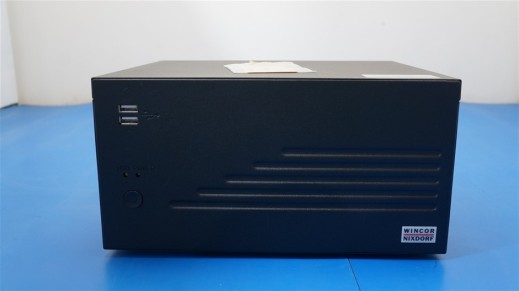Machine:
Wincor Nixdorf BEETLE POS Mini Retail PC
Specifications
- Genuine Intel Atom CPU 230 @ 1.60GHz, 1 Core(s)
- 544MB RAM
- 160GB SATA Hard Drive
- RTL8101/2/6E PCI Express Fast/Gigabit Ethernet controller, Ethernet
- Intel, 82945G/GZ Integrated Graphics Controller
- Intel, NM10/ICH7 Family High Definition Audio Controller
- USB Port (6), LAN Port (1), VGA Port (1), Non Powered RS232 Port (1), Powered RS232 Port (3)
In no case was I prepared to sweat over it. What this means is that it is quite possible that any one of these would have worked fine. But I did not want to spend the time. In the end, my criterion was ‘Does it work out of the box for a lazy person’.
Now, that is just not fair to some OSs. I mean, Debian is a huge, polished project, while many distros are bespoke and the result of a singular vision. This is old, obscure hardware, and when you have limited time and resources, you’re not going to develop for this machine. So please do not take anything here as a value judgement on the OS in question. It is merely observation.
This is especially true in that my main intent for the box is to use it as a backup fileserver, which does not need Xorg at all. X just means I can run a graphical browser (albeit a light one, like netsurf) when I need to hunt up solutions to issues. I have found that FLWM coupled with lightweight applications (netsurf, the old Ted RTF word processor, xosview and so on) gives me a perfectly responsive experience. But I’m not going to fire up Firefox or LibreOffice on 512MB of RAM! surf works fine for the modern web.
All are stable releases as of May 2020, unless noted as rolling.
Slackware 14.2 32-bit — installed readily, X could not configure itself. Did not find a video card.
Kali Linux, 64-bit — this is effectively Debian. It installed readily, everything worked, and it was just a matter of choosing lightweight applications.
SUSE Tumbleweed 32-bit — (rolling release) installer could not complete. I think it ran out of RAM. Again, not a shock — it’s not for old, low spec machines.
Mageia 7.1 32-bit — installer threw an error saying it ran out of memory, and stopped. I quite like Mageia, but it did not suit in this case.
Alpine 3.11 32-bit — could not find/drive the Ethernet adapter. I did not really try to solve this problem.
ReactOS 0.4.13 — (alpha software) could not boot the installer. Again, not unreasonable — ReactOS is not production software.
Slitaz 32-bit rolling release — did not boot. This did surprise me, because I’ve found SliTaZ to be a really handy lightweight distro. But as I said, my hardware is a bit old and obscure. Maybe it did not like the USB CD drive I was using…?
OpenBSD 6.7 — installed, worked out of the box, am using it as the #1 OS on the machine, since I want to use it as a little family file server, amongst other things. I’m not as familiar with BSD as Linux, and I don’t think I set up the partitions ideally (/usr is too small), so that’s a lesson learned. I would not recommend messing around with BSD disklabel trying to allocate partitions on a disk that is already occupied in some places by another OS, to be honest. But X worked fine, it uses relatively few system resources, and the control of daemons and services is nice. Installation relatively manual compared to say Kali.
TinyCore — installed, worked fine. I had some trouble setting up the bootloader — it installed LILO over the GRUB that I had set up with Kali Linux, and for a while I could only boot TC. Then I installed grub on TC, it found the config file that Kali had written to the boot blocks, and I was able to boot into Kali and then set up 40_custom to boot TC, and later OpenBSD. I only put TC on to see what I could see. It sits on a 5GB partition and runs very nicely. Amazing little distribution.
Conclusion
In the end I have Kali, TC and OpenBSD on the HDD, with a grub menu at the front and OpenBSD set as the default.
For an inexperienced user, it’s hard to go past Debian or one of its derivatives. I liked Kali because the initial install image download is less than half the size of the Debian netboot iso image, and seeing as I did not plan to install a lot of stuff anyway, it made sense to use small install media.
A BSD just seemed to make sense on an older machine that was going to spend a lot of its time serving files, and FreeBSD seems too shiny and more suited to newer hardware, and I’ve messed around with NetBSD and I know it could have done a perfectly good job, so it seemed like a good time to try OpenBSD.
OpenBSD needs more user knowledge than Debian to install, and one must be prepared to read the documentation — but the documentation is second to none. When I first installed it, I did not even know that I needed to use pkg_add to install more software! A few days later, we’re using it as a family file server to back up photos and movies. A more helpful partitioner/disklabel editor would be nice, I must say. On the other hand, I really like the relatively minimal yet functional system you get after the install. You can add to it very easily, but it’s not crowded with lots of stuff you never asked for. When I first started it up I typed lynx then links then wget then … and none was already installed. So what is on the system is what I put there!


